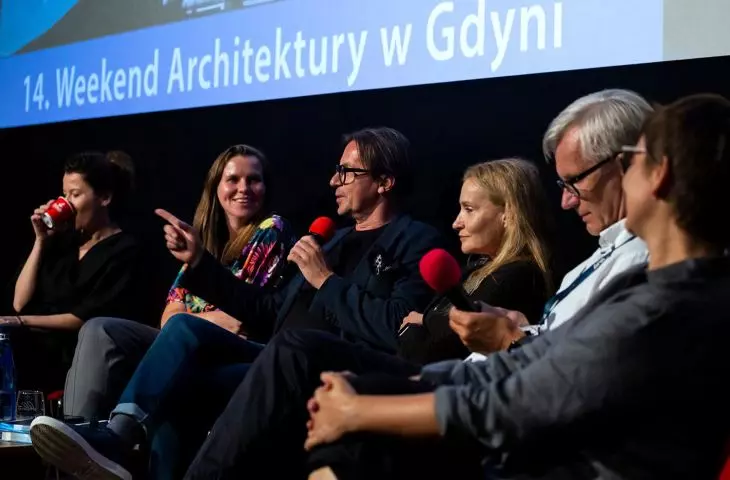Do we need experiments in architecture and urban planning today? Or should we go back to the patterns of the past and draw from them? And actually, where is a human being in all this? The 14th edition of the Architecture Weekend in Gdynia under the slogan "Experiment" is behind us.
The 14th edition of the Weekend of Architecture in Gdynia was held under the motto "Experiment"
Photo: Małgorzata Szura-Piwnik | Illustrations courtesy of the organizers
Once again, the Gdynia Development Agency was supported in organizing the festival by Dorota Sibinska and Filip Domaszczynski of the Warsaw-based XYStudio studio. Various events with the prefix "Archi" were held in Gdynia from August 28 to September 1 this year, culminating in lively "Archi Discussions."
Jacek Debis and Dorota Sibinska
Photo: Przemysław Kozłowski | Illustrations courtesy of the organizers
to experiment or not?
The debates showed the often divergent positions of the architectural community — Tomasz Konior, architect and founder of Konior Studio, encouraged above all to learn from the past, to draw from the old models of Italian cities such as Venice, Bologna or Siena and to avoid mistakes like Brasília, the capital of Brazil, a modernist experiment by Lucio Costa, Oscar Niemeyer and Joaquim Cardozo. This "cursed place", according to Tomasz Konior, is an example of how architects and urban planners over the last hundred years have moved away from human problems and started creating places that are completely unfit for life.
I'm a big believer that instead of experimenting on people and looking for some strange things we should first do our homework and look at what previous centuries, generations have left us — said Tomasz Konior.
Tomasz Konior (Konior Studio) talked about time in architecture
Photo: Małgorzata Szura-Piwnik | Illustrations courtesy of the organizers
In turn, experiments were encouraged by Jakub Szczęsny, an architect and regular columnist, who reminded us that we should not forget about the reality in which we live and take into account current problems, which are primarily related to climate change. So architects should think ahead, because people for years will function with what we create for them, even if they are architectural sins.
Jakub Szczęsny talked about experimental asylums and enclaves
Photo: Małgorzata Szura-Piwnik | Illustrations courtesy of the organizers
carefully and bit by bit
So if to experiment, how? According to Szymon Wojciechowski of the APA Wojciechowski studio — cautiously, because the experiment may fail, and its consequences can be significant and costly, both economically and environmentally. In turn, Dominika Zielinska encouraged bold actions, but on a small scale and bit by bit. In her opinion, it is important to suspend the bar realistically high, so that we still want to jump over it. An example of this can be done on a small scale — if we see on a small trial that something doesn't work, we can always step back and try another solution. Wanting to see how biomaterials will behave in our project, we don't have to risk the whole wall — we can introduce a square meter to observe how a material ages.
Archi Discussion: How will architects design our future? moderator: Dorota Sibinska; speakers: Jakub Bladowski (Designbotic, Roark Studio), Marlena Happach (NID), Dominika Zielińska (architect), Tomasz Konior (Konior Studio), Dorota Szlachcic (Szlachcic Architekci), Szymon Wojciechowski (APA Wojciechowski), Justyna Dziedziejko (topoScape)
Photo: Przemysław Kozłowski | Illustrations courtesy of the organizers
drawing conclusions
In the process of experimentation, the element of observation is extremely important, as emphasized by Marlena Happach, former Architect of the City of Warsaw and acting director of the National Heritage Institute, as well as listening, including through participatory processes, to the needs of the users of the spaces in question, especially those who are weaker and usually do not speak up about their needs, as pointed out by Justyna Dziedziejko, a landscape architect from the topoScape studio.
Archi Discussion: How will architects design our future? Jakub Bladowski, Marlena Happach, Dominika Zielińska
Photo: Przemysław Kozłowski | Illustrations provided courtesy of the organizers
"We really need a lot of thoughtfulness and a sense of life and its absolutely real needs" — added Jacek Koltan, a philosopher and plenipotentiary of the director of the European Solidarity Center, stressing that single actions in space will not bring good results if we do not look at space holistically. In his opinion, in order to be able to act point-by-point, one needs to know a lot about the whole organism.
Monika Arczynska (A2P2) introduced the idea of public consultation
Photo: Przemysław Kozłowski | Illustrations courtesy of the organizers
The conversation about whether and how we should experiment was accurately summed up by one of the participants of the event sitting in the audience, asking straightforwardly whether for architects the human being is really still the most important? But is ego, won awards and environmental recognition more important? This question, although left without a clear answer, received applause from both the speakers and the audience. Perhaps the time has come for us to ask it anew.
Broadcasts of the Archi Lecture and Archi Discussion can be seen and listened to on the YouTube channel of the Gdynia Modernism Route:
City Here and Now
Panelists: Agnieszka Fryzowska-Jurecka (LIS Gdynia), Tomasz Konior (Konior Studio), Jakub Szczęsny (SZCZ), Jacek Kołtan (plenipotentiary of the ECS director), Agnieszka Kalinowska-Sołtys (APA Wojciechowski), Jacek Droszcz (Studio Kwadrat)
How will architects design our future?
Can experiments in architecture change future generations?
Panelists: Dorota Szlachcic (Szlachcic Architects), Tomasz Konior (Konior Studio), Szymon Wojciechowski (APA Wojciechowski), Dominika Zielińska (architect), Jakub Bladowski (Designbotic, Roark Studio), Justyna Dziedziejko (topoScape), Marlena Happach (NID)







































































